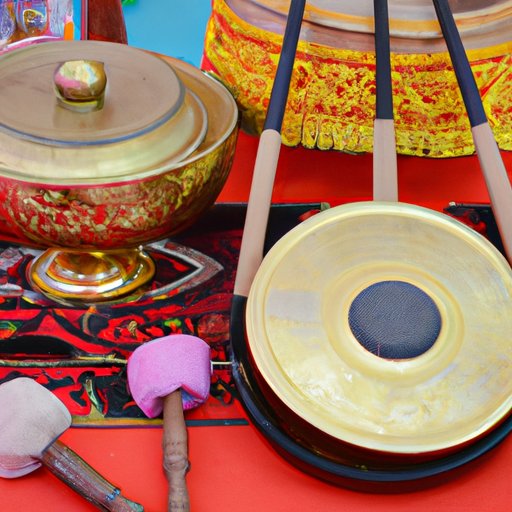Introduction
Culture is defined as “the beliefs, customs, practices, and social behaviors of a particular nation, people, or other social group” (Dictionary.com). This article will explore the basic components that are present in all cultures, including values and beliefs, rituals and customs, language, art, music, and literature. By examining these components, we can gain insight into what unites cultures around the world, as well as what sets them apart.

Analyzing Common Components in Various Cultures
In order to understand the common components of all cultures, it is important to examine the values and beliefs shared by many cultures, the rituals, customs, and traditions of different cultures, and the language, art, music, and literature of different cultures.
Examining Values and Beliefs Shared by Many Cultures
Values and beliefs are an essential part of any culture. According to research conducted by Psychology Today, some of the universal values shared by many cultures include respect for others, honesty, loyalty, courage, humility, and compassion. These values are often expressed in different ways depending on the culture, but they provide a common foundation for understanding cultural differences.
Comparing Rituals, Customs, and Traditions of Different Cultures
Rituals, customs, and traditions are also important components of culture. These elements vary greatly from culture to culture and can range from religious ceremonies to everyday habits. For example, the New Year’s celebration in China involves eating dumplings and setting off fireworks, while in Japan it involves eating soba noodles and visiting shrines. Despite the differences, these rituals and customs serve to bring communities together and create a sense of identity and belonging.
Examining Language, Art, Music, and Literature of Different Cultures
Language, art, music, and literature are also essential elements of culture. They provide insight into how different cultures view the world and express their values and beliefs. For example, the Japanese haiku is a form of poetry that reflects the importance of nature and simplicity in Japanese culture. Similarly, traditional Chinese art often incorporates symbols and images associated with Confucianism and Taoism. These elements are unique to each culture, yet they serve to unite people of different backgrounds and provide a common language for understanding.

Examining the Similarities between Different Cultures
When examining the components of all cultures, it is also important to consider the similarities between them. While each culture has its own unique elements, there are certain common elements that unite them. These elements include shared values and beliefs, rituals and customs, language, art, music, and literature.
Identifying Common Cultural Elements
One of the most obvious ways in which cultures are similar is through the common elements they share. These elements can be found in various forms across different cultures, such as traditional clothing, food, and architecture. For example, the yukata, a type of traditional Japanese clothing, is also popular in other countries such as Korea, China, and Vietnam. Similarly, the traditional Korean dish kimchi is also enjoyed in Japan, China, and other parts of Asia.
Discussing the Impact of Globalization on Cultural Similarities
Globalization has also had an impact on the similarities between cultures. As people travel more and technology advances, cultures become more connected, which leads to the sharing of ideas, beliefs, and customs. This can be seen in the spread of popular foods, music, and fashion trends around the world. As cultures become increasingly interconnected, they become more similar in terms of the values, beliefs, and customs they share.
Exploring the Values and Beliefs Shared by Many Cultures
As previously mentioned, values and beliefs are an essential component of culture. These values and beliefs provide a common ground for understanding and connecting with people from different cultures. By examining them, we can gain insight into the similarities and differences between cultures.
Discussing the Importance of Shared Values and Beliefs
Shared values and beliefs are important because they provide a sense of commonality among cultures. They can help us to recognize and appreciate the diversity of cultures around the world, while still recognizing the similarities between them. As HuffPost states, “By exploring shared values, we can bridge cultural divides and foster understanding, empathy, and respect.”
Examining How Those Values and Beliefs are Expressed in Different Cultures
The way in which values and beliefs are expressed varies from culture to culture. For example, in some cultures, respect is shown through gestures such as bowing or hand-shaking, while in others it is expressed through words or actions. Similarly, the concept of loyalty may be expressed differently in different cultures; in some cultures, it may involve being faithful to one’s family, while in others it may involve being loyal to one’s country or religion.
Comparing the Rituals, Customs, and Traditions of Different Cultures
Rituals, customs, and traditions are important components of culture, as they provide a way to connect with the past and celebrate the present. By comparing the rituals, customs, and traditions of different cultures, we can gain insight into the similarities and differences between them.
Identifying Common Rituals, Customs, and Traditions
There are certain rituals, customs, and traditions that are shared by many cultures. These include celebrations such as weddings, births, graduations, and festivals, as well as daily activities such as greeting each other and sharing meals. By understanding these common elements, we can better appreciate the diversity of cultures around the world.
Examining the Differences Between Cultures
While there are many similarities between cultures, there are also differences. For example, some cultures may have different customs for greeting each other, or different religious rituals and beliefs. By examining these differences, we can gain a deeper understanding of each culture and its unique characteristics.
Examining the Language, Art, Music, and Literature of Different Cultures
Language, art, music, and literature are also important components of culture. They provide insight into the values and beliefs of different cultures and can help us to understand and appreciate their uniqueness. By examining these elements, we can gain a better understanding of the similarities and differences between cultures.
Discussing the Importance of Language, Art, Music, and Literature to Culture
Language, art, music, and literature are important elements of culture. They provide a way to express and preserve cultural values, beliefs, and customs. According to UNESCO, “Cultural heritage and arts act as vehicles of transmission of knowledge and can help to build bridges between cultures and societies.” By understanding these elements, we can gain a greater appreciation for the diversity of cultures around the world.
Examining How These Elements Differ Across Cultures
The language, art, music, and literature of different cultures often differ significantly. For example, the language spoken in one culture may be completely different from that spoken in another. Similarly, the art, music, and literature of different cultures often reflect the values, beliefs, and customs of those cultures. By examining these elements, we can gain a greater understanding of the uniqueness of each culture.
Conclusion
In conclusion, this article has explored the common components of all cultures, including values and beliefs, rituals and customs, language, art, music, and literature. By examining these components, we can gain insight into what unites cultures around the world, as well as what sets them apart. By understanding these elements, we can gain a greater appreciation for the diversity of cultures around the world and the values, beliefs, and customs they share.
(Note: Is this article not meeting your expectations? Do you have knowledge or insights to share? Unlock new opportunities and expand your reach by joining our authors team. Click Registration to join us and share your expertise with our readers.)
